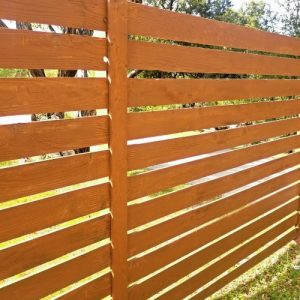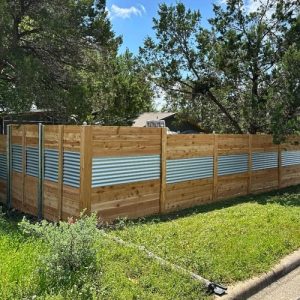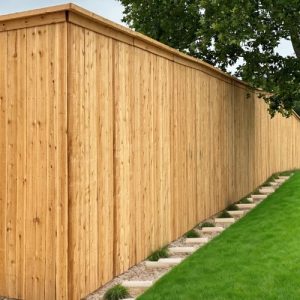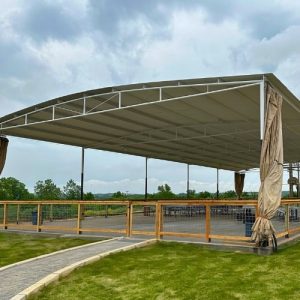Installing a fence is straightforward, but many factors can affect the total cost. Material choice is a major one—wood can be cheaper upfront but demands more maintenance, while vinyl is pricier initially yet saves you on upkeep. Labor costs also vary, depending on the complexity of installation and local rates. Don’t forget permits and site preparation, which add to the budget. Are you curious how different materials and other factors influence the final price? Let’s explore the details to help you make an informed decision.
Key Takeaways
- The cost of wooden fences varies greatly, influenced by material quality and labor, ranging from $15 to $30 per linear foot.
- Vinyl fences typically cost between $15 to $40 per linear foot, including materials and labor.
- Chain-link fences cost from $7 to $20 per linear foot, depending on material grade and installation complexity.
- Metal and aluminum fences cost between $20 and $40 per linear foot and offer durability and aesthetic appeal.
- Local labor rates, permit fees, and site preparation can significantly impact the fence installation cost.
Types of Fencing Materials
 When considering the types of fencing materials available, you’ll find several options, each with distinct advantages and drawbacks. Wood, vinyl, aluminum, and steel are the most common choices. Wood offers a classic look, enhancing fencing aesthetics with its natural appearance. However, it requires regular maintenance and has a significant environmental impact due to deforestation and chemical treatments. Vinyl fencing is a low-maintenance alternative that is resistant to weather and pests. While its initial production involves petrochemicals, its long lifespan can offset the environmental impact.
When considering the types of fencing materials available, you’ll find several options, each with distinct advantages and drawbacks. Wood, vinyl, aluminum, and steel are the most common choices. Wood offers a classic look, enhancing fencing aesthetics with its natural appearance. However, it requires regular maintenance and has a significant environmental impact due to deforestation and chemical treatments. Vinyl fencing is a low-maintenance alternative that is resistant to weather and pests. While its initial production involves petrochemicals, its long lifespan can offset the environmental impact.
Aluminum fences provide a sleek, modern look and are highly durable. They’re also recyclable, making them a more eco-friendly option. However, they may not offer the same level of privacy as wood or vinyl. Steel fencing is incredibly strong and secure, ideal for high-security needs. Galvanized or powder-coated finishes enhance its durability and resistance to rust. Steel production is energy-intensive but can be recycled, reducing its environmental footprint. Each material varies in fencing aesthetics and environmental impact, so you must weigh these factors carefully to select the best option.
Cost of Wooden Fences
When considering the cost of wooden fences, you need to account for the impact of material quality, ranging from pressure-treated pine to high-end cedar. Labor and installation costs can also vary significantly based on local rates and the complexity of the installation. Additionally, you’ll want to factor in maintenance and longevity, as wooden fences require regular upkeep to prevent rot and extend their lifespan.
Material Quality Impact
Understanding the impact of material quality on the cost of wooden fences is essential for budgeting your fencing project accurately. High-quality wood guarantees durability and fulfills your aesthetic preferences and sustainability considerations. Different wood types can significantly affect your overall costs.
- Pressure-Treated Pine: This option is economical and widely available. It’s treated to resist pests and decay, making it durable and cost-effective.
- Cedar: Known for its natural resistance to rot and insects, cedar is more expensive than pine but requires less maintenance. Its rich color also adds aesthetic value.
- Redwood: This premium choice offers exceptional durability and a beautiful finish. It’s one of the most expensive options but provides long-term value.
- Composite Wood combines wood fibers with plastic, making it highly durable and low-maintenance. Although it has a higher initial cost, it offers excellent longevity and sustainability.
Each wood type has its benefits and drawbacks regarding cost, durability, and environmental impact. By carefully selecting the suitable material, you can balance your budget while meeting your sustainability considerations and aesthetic preferences.
Labor and Installation
 Labor and installation costs are essential to any wooden fence project and often constitute a considerable portion of the overall budget. When considering these expenses, it’s important to understand the fence installation techniques and labor cost factors that influence the final price. Professional installers utilize precise methods such as post setting, rail attachment, and panel alignment to ensure the fence’s stability and durability. Each phase of installation demands skilled labor, directly impacting costs. Labor cost factors include the complexity of the fence design, the type of wood used, and the terrain of your property. For instance, installing a fence on uneven ground or around obstacles requires more time and expertise, increasing labor charges.
Labor and installation costs are essential to any wooden fence project and often constitute a considerable portion of the overall budget. When considering these expenses, it’s important to understand the fence installation techniques and labor cost factors that influence the final price. Professional installers utilize precise methods such as post setting, rail attachment, and panel alignment to ensure the fence’s stability and durability. Each phase of installation demands skilled labor, directly impacting costs. Labor cost factors include the complexity of the fence design, the type of wood used, and the terrain of your property. For instance, installing a fence on uneven ground or around obstacles requires more time and expertise, increasing labor charges.
Additionally, high-quality woods like cedar or redwood raise material costs and necessitate careful handling and installation, further elevating labor expenses. You should also factor in regional labor rates, which can vary considerably. Urban areas typically have higher labor costs compared to rural locations.
Maintenance and Longevity
Proper maintenance is essential for the longevity and cost-effectiveness of wooden fences. Your investment can deteriorate quickly without regular upkeep, leading to higher replacement costs.
To maximize the lifespan of your wooden fence, you must focus on several key fence care practices that address common longevity factors.
- Sealing and Staining: Apply a quality sealant and stain every 2-3 years to protect the wood from moisture, UV rays, and pest damage.
- Regular Inspections: Conduct routine inspections to identify and repair cracks, warping, or signs of rot. Early detection prevents minor issues from escalating.
- Cleaning: Clean your fence annually to remove dirt, mold, and mildew. Use a mild detergent, soft brush, or power washer set to low pressure.
- Proper Installation: Verify that your fence is installed with a slight gap at the bottom to avoid ground contact, which accelerates decay.
Explore More Topics:
Price for Vinyl Fences
When considering vinyl fences, you’ll need to account for material and labor costs, typically ranging from $15 to $40 per linear foot. Although initial expenses might be higher than other materials, vinyl offers significant long-term maintenance savings due to its durability and low upkeep requirements. This makes it a cost-effective option, particularly for those seeking minimal maintenance.
Material and Labor Costs
Installing a vinyl fence can significantly enhance the aesthetics and security of your property, but understanding the material and labor costs involved is vital for budgeting.
Vinyl fencing is known for its durability and low maintenance but is expensive. Typically, vinyl fence materials range from $20 to $40 per linear foot. You should also account for labor costs, which can vary based on your location and the complexity of the installation.
To break down the costs, consider the following:
- Materials: Vinyl panels, posts, and other components.
- Labor: Professional installation fees often range from $30 to $50 per hour.
- Additional Supplies: Concrete for setting posts, brackets, and caps.
- Permit Fees: Local regulations may require permits, adding to the total cost.
When planning your project, consider fence financing options that can spread your expenses over time. If you’re considering a DIY installation, you could save on labor costs, but following proper installation guidelines is imperative to guarantee the fence’s longevity. These DIY installation tips can help you avoid common pitfalls and achieve a professional finish.
Long-Term Maintenance Savings
 Choosing vinyl fencing offers significant long-term maintenance savings, making it an attractive option for many homeowners. Unlike wood or metal, vinyl doesn’t require regular painting, staining, or rust-prevention treatments. This drastically reduces maintenance frequency, saving you time and money over the years. Vinyl fences boast a remarkable amount, often exceeding 20-30 years, with minimal upkeep. The material is resistant to pests, rot, and harsh weather conditions, eliminating the need for frequent repairs or replacements.
Choosing vinyl fencing offers significant long-term maintenance savings, making it an attractive option for many homeowners. Unlike wood or metal, vinyl doesn’t require regular painting, staining, or rust-prevention treatments. This drastically reduces maintenance frequency, saving you time and money over the years. Vinyl fences boast a remarkable amount, often exceeding 20-30 years, with minimal upkeep. The material is resistant to pests, rot, and harsh weather conditions, eliminating the need for frequent repairs or replacements.
Vinyl’s durability guarantees that it maintains its aesthetic appeal without the constant touch-ups required by other materials. Cleaning a vinyl fence is straightforward; typically, a simple wash with soap and water suffices. This ease of maintenance contributes to its cost-effectiveness. Over time, the savings on paint, sealants, and labor can be substantial, making the initial higher cost of vinyl a wise long-term investment.
Chain-Link Fence Pricing
Chain-link fence pricing can vary considerably depending on several factors, including material quality, fence height, and installation complexity.
When considering chain-link fencing, you’ll find costs influenced by the following variables:
- Material Quality: Higher-grade galvanized steel costs more but enhances chain link durability, ensuring a longer lifespan.
- Fence Height: Standard heights range from 4 to 6 feet, with taller fences increasing material and installation costs.
- Coating and Finish: Vinyl-coated chain-link fences add a layer of protection and enhance chain-link aesthetics, but they are more expensive.
- Installation Complexity: Challenging terrain and additional features like gates can drive up labor costs.
Basic chain-link fencing materials typically cost between $7 and $12 per linear foot. Labor costs, which depend on local rates and project complexity, generally range from $10 to $20 per linear foot. A standard 150-foot long, 6-foot high chain-link fence, including materials and labor, could cost between $2,550 and $4,800. Understanding these factors helps you make informed decisions, ensuring you get the most durable and aesthetically pleasing chain-link fence within your budget.
Metal and Aluminum Fencing Costs
While chain-link fences offer a cost-effective solution, metal and aluminum fencing provide an upscale alternative with improved durability and aesthetic appeal. Metal fencing advantages include superior strength, resistance to weathering, and various design options. Typically, metal fences are made from steel or wrought iron, which are known for their robustness and ability to withstand harsh environmental conditions. Depending on the material and design intricacies, metal fencing costs range from $20 to $30 per linear foot.
On the other hand, aluminum fencing stands out for its lightweight nature and corrosion resistance, making it an excellent choice for coastal areas or regions with high humidity. Aluminum fencing durability guarantees that it won’t rust or degrade over time, maintaining its appearance with minimal maintenance. Prices for aluminum fencing generally fall between $25 and $40 per linear foot. Both metal and aluminum fencing offer a high-end look that can significantly enhance your property’s curb appeal. While they may have a higher initial cost than other types, their long-lasting nature and minimal upkeep can prove to be worthwhile investments in the long run.
Labor and Installation Fees
Understanding labor and installation fees is essential when estimating the total cost of a fencing project. These fees can vary greatly depending on several factors that directly impact the complexity and duration of the work required. Your chosen fence design, for instance, plays a key role in determining labor costs. More intricate designs typically demand higher craftsmanship, which in turn increases labor expenses. Additionally, securing installation permits is another essential aspect that influences labor fees. The process of obtaining permits can be time-consuming and may involve inspection fees, all contributing to the overall cost.
Here are some key elements affecting labor and installation fees:
- Fence design complexity: Intricate designs require more time and specialized skills.
- Terrain conditions: Uneven or rocky ground can complicate installation, increasing labor time.
- Local labor rates: Wages for skilled labor vary by region and can significantly impact costs.
- Permit requirements: Depending on local regulations, you may need to secure various permits before installation.
Additional Costs to Consider
 When budgeting for your fencing project, it’s essential to factor in the myriad additional costs that can arise beyond just materials and labor. One of the first items to take into account is permit fees. Depending on your locality, you may need a permit before installing your fence. This process can vary widely in cost, and failure to secure the necessary permits can result in fines or having to redo sections of the fence.
When budgeting for your fencing project, it’s essential to factor in the myriad additional costs that can arise beyond just materials and labor. One of the first items to take into account is permit fees. Depending on your locality, you may need a permit before installing your fence. This process can vary widely in cost, and failure to secure the necessary permits can result in fines or having to redo sections of the fence.
Another significant consideration is verifying your property lines. Hiring a surveyor to determine your property boundaries accurately can prevent costly disputes with neighbors. Misplaced fences can lead to legal issues, requiring you to remove and reinstall sections at your own expense.
Additionally, you should account for site preparation. This can include clearing vegetation, leveling the ground, and removing old fencing. These tasks require time and potentially specialized equipment, adding to your overall costs. Take advantage of potential utility line adjustments, too. Calling 811 to mark underground utilities is free, but if adjustments are needed, this can add to your expenses.
Tips for Budgeting Your Fence
A meticulous budget for your fence installation is vital for avoiding unexpected financial setbacks. Start by considering the type of fence you want. Fence style considerations are essential since materials like wood, vinyl, and metal vary significantly in cost. For example, a wooden fence might be cheaper upfront but require more maintenance in the long term, impacting your budget.
Next, decide whether you’ll hire professionals or tackle a DIY project. DIY installation tips can save you labor costs, but remember to factor in the price of tools and additional materials you might need.
Here’s a quick checklist to guide your budgeting process:
- Material Costs: Research prices for different materials to find one that fits your budget and meets your needs.
- Labor Expenses: If hiring a contractor, get multiple quotes to find the best price without compromising quality.
- Permits and Zoning: Check local regulations to understand permit fees and zoning laws, which can add to the overall cost.
- Maintenance: Account for long-term maintenance expenses, especially for materials like wood that require periodic treatments.
Conclusion
When budgeting for a fence, remember that the type of material is just the tip of the iceberg. Wooden fences may seem cheaper initially, but the ongoing maintenance can add up. Vinyl fences, though pricier upfront, save you money in the long run due to their durability. Remember, labor costs vary based on installation complexity and terrain. Factor in additional expenses like permits and site prep. Plan wisely; your perfect fence will stand tall without breaking the bank.
